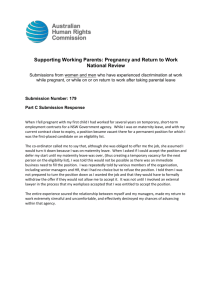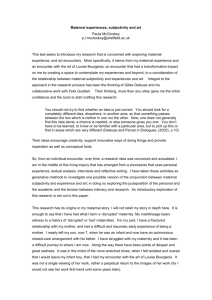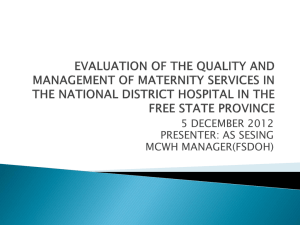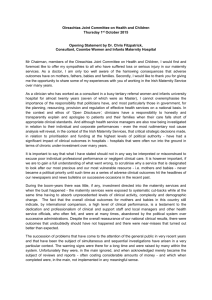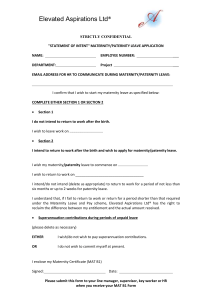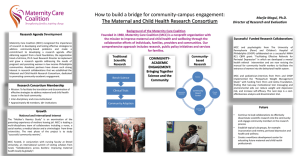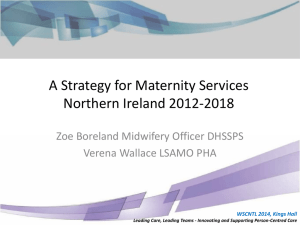Setting the scene
advertisement
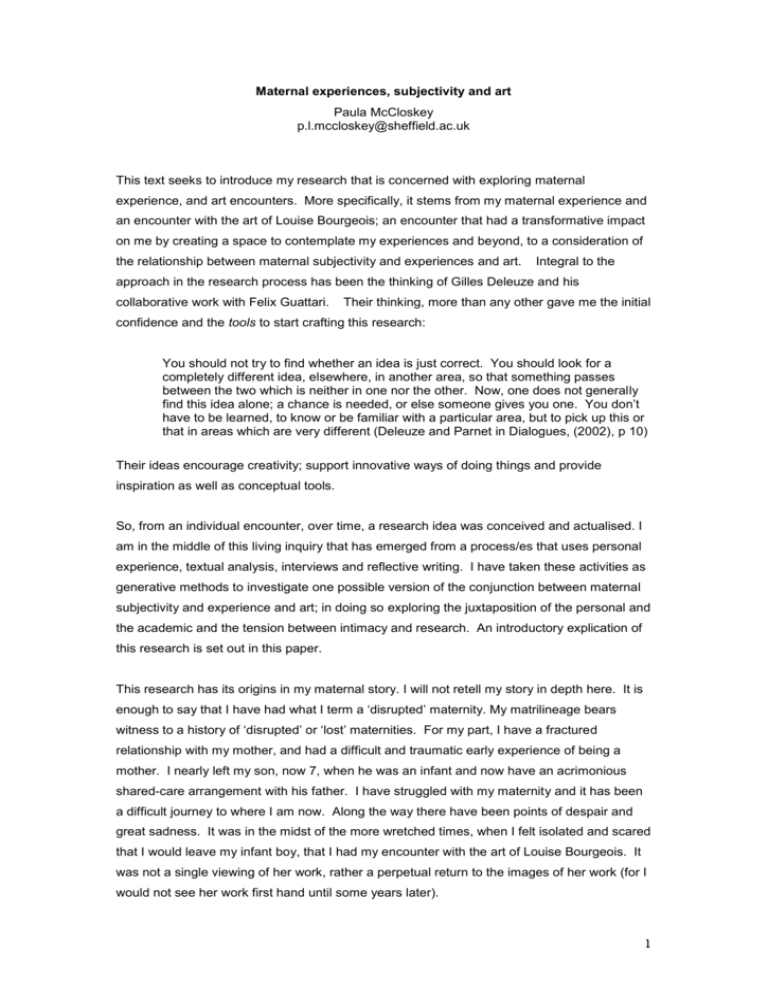
Maternal experiences, subjectivity and art Paula McCloskey p.l.mccloskey@sheffield.ac.uk This text seeks to introduce my research that is concerned with exploring maternal experience, and art encounters. More specifically, it stems from my maternal experience and an encounter with the art of Louise Bourgeois; an encounter that had a transformative impact on me by creating a space to contemplate my experiences and beyond, to a consideration of the relationship between maternal subjectivity and experiences and art. Integral to the approach in the research process has been the thinking of Gilles Deleuze and his collaborative work with Felix Guattari. Their thinking, more than any other gave me the initial confidence and the tools to start crafting this research: You should not try to find whether an idea is just correct. You should look for a completely different idea, elsewhere, in another area, so that something passes between the two which is neither in one nor the other. Now, one does not generally find this idea alone; a chance is needed, or else someone gives you one. You don’t have to be learned, to know or be familiar with a particular area, but to pick up this or that in areas which are very different (Deleuze and Parnet in Dialogues, (2002), p 10) Their ideas encourage creativity; support innovative ways of doing things and provide inspiration as well as conceptual tools. So, from an individual encounter, over time, a research idea was conceived and actualised. I am in the middle of this living inquiry that has emerged from a process/es that uses personal experience, textual analysis, interviews and reflective writing. I have taken these activities as generative methods to investigate one possible version of the conjunction between maternal subjectivity and experience and art; in doing so exploring the juxtaposition of the personal and the academic and the tension between intimacy and research. An introductory explication of this research is set out in this paper. This research has its origins in my maternal story. I will not retell my story in depth here. It is enough to say that I have had what I term a ‘disrupted’ maternity. My matrilineage bears witness to a history of ‘disrupted’ or ‘lost’ maternities. For my part, I have a fractured relationship with my mother, and had a difficult and traumatic early experience of being a mother. I nearly left my son, now 7, when he was an infant and now have an acrimonious shared-care arrangement with his father. I have struggled with my maternity and it has been a difficult journey to where I am now. Along the way there have been points of despair and great sadness. It was in the midst of the more wretched times, when I felt isolated and scared that I would leave my infant boy, that I had my encounter with the art of Louise Bourgeois. It was not a single viewing of her work, rather a perpetual return to the images of her work (for I would not see her work first hand until some years later). 1 It is difficult to write about an art-encounter after the (albeit recurring) ‘event’. It is not something that can be easily described or captured in a written text, if at all. It is maybe only possible to discuss its affects, what it does or did. Something in the world forces us to think. This something is an object not of recognition but of a fundamental encounter (Deleuze, 1994, p 139) I will not attempt a full analysis of the affects or effects here, except in general terms. Louise Bourgeois’ work is not exclusively maternal in nature, however for me something happens when I see her work that moves me profoundly. It was also not one single work, some more than others, but it was an unspeakable something that I felt when I looked at and experienced her work. I do not see her maternity, nor mine. But her work translates a feeling, an emotion that spoke to my maternal-self. It connected with that hidden part of me that held the ball of sadness, regret, guilt, fear and hope that I associate(d) with my maternity. It provided a meditative pause that I would return to over time, leading to a questioning of maternity, of mine and of others in a hope of gaining some understanding of maternity and in doing so generate understandings that may transcend the bounds of my own maternal experience. It is this last part that is important to this research: With a genuine encounter…(o)ur typical ways of being in the world are challenged, our systems of knowledge disrupted. We are forced to thought. The encounter then operates as a rupture in our habitual modes of being and thus in our habitual subjectivities. It produces a cut, a crack. However this is not the end of the story, for the rupturing encounter also contains a moment of affirmation, the affirmation of a new world, in fact a way of seeing and thinking this world differently. This is the creative moment of the encounter that obliges us to think otherwise. Life, when it truly is lived, is a history of these encounters, which will always necessarily occur beyond representation (O’Sullivan, 2006, p 1) The road from my maternal story and art-encounter to the research has not followed a linear route. From this encounter, in the aftermath of the most difficult time in my maternal journey, I had the time and space to reflect on, among other things, the importance of my relationship to this art-work. I began to think about maternity in wider terms than my own experience and about the relationship between maternity and art from different angles. This desire to inquire into maternity and art needed some nurturing. I sought out knowledges old and new. I started to question and write about my maternal experience and subjectivity and started to think of what I did know, my own experience, of course, but also those of other mothers I knew, as friends, in the media, in literature, the mothers with whom as a social worker I have worked for years, of my own mothers (my mother, grandmother and great-grandmothers). In turning to literature both fictional and other, I returned to texts that had affected me as a young woman (Simone de Beauvoir’s The Second Sex, Shulamith Firestone The Dialectic of Sex: The Case for Feminist Revolution, Alice Walker’s Meridian, Buchi Emecheta The Joys of Motherhood and Toni Morrison’s Beloved) and later scholarly texts written by women that 2 used experience in order to theorise maternity (Julie Kristeva’s Stabat Mater and Adrienne Rich’s Of Women Born, along with Patricia Hill Collin’s Black Feminist Thought). As I grappled with my experience and texts I began to explore the relationship of maternity and art, seeing how changes in women’s writing on their own experiences of maternity were concomitant with women artists recuperating the maternal from mostly male depictions of the Madonna and child that had littered the art world: As mothers, as daughters, as artists, but most of all as women we all have a stake in displacing the bio-maternal determinism that lies hidden in the seemingly benign representations of maternity. Women artists have always worked in a Catch-22 situation and the catch is maternity – an “original” division of labor: women have babies: men create art (Isaak, 1996, p 140). Of course, women create art, and they have created works that contemplate maternity too in diverse and evocative ways (artists such as Mary Kelly, Paula Rego, Helen Chadwick, Ellen McMahon, Lena Semic, Sarah Pucill, Christine Wilks, Whitney McVeigh, Frida Kahlo, Kiki Smith, Helen Sargeant, Cindy Sherman, Helen Knowles, Judy Glantzman, Monica Bock, Sarah Webb, Renée Cox, Deirdre Donoghue, Helena Walsh, Anna Furse, Hannah Wilke, Tracy Emin). I also started to seek out contemporary women artists who would speak to me about their work and their maternity. In the midst of this activity a dialogue was set up, between the texts, the art work, the artists, and my ongoing experience. This dialogue became actualised, or at least partially so, in notebooks that I started to keep, and as they developed, the writing and drawings held by these tiny pages in themselves not only capture some of this dialogue, but were/are part of it. There may have been different trajectories that this research could have taken, but from the initial fervent, yet rigorous, activity one viable research project emerged. It takes shape as a multiplicitous project that is concerned with exploring maternal experience AND maternal subjectivity AND maternity’s relationship to art from a situated lens (Haraway, 1991). It explicates its location in my experience ‘I’ and then traces the route to others non-Is (in the texts, art and meetings with artists). It draws into its body a number of seemingly disparate elements and heterogeneous terms establishing liaisons and relations between personal experiential accounts, psychoanalytical thinking, and sociological thinking, discussions of art, philosophy, visual images and historical references. It is an assemblage1 (Deleuze and Guattari, 1987). Its status as an assemblage does not prevent it from containing assemblages within itself, and it will also enter into new assemblages with the readers, other literature and research and so on. Deleuze and Guattari conceptualise an assemblage as: “…as in all things, there are lines of flight, movements of deterritorilization and destratification. Comparative rates of flow on these 1 lines produce phenomena of relative slowness and viscosity, or the contrary, of acceleration and rupture. All this, lines and measurable speeds, constitute an assemblage” (Deleuze and Guattari, 1987, p 4). 3 So, the research is concerned with reflexivity and meditation but it is also about doing, it is about developing praxis. The term praxis is used to capture the dynamic nature of a traversal between experience, written texts, the existent art and practice which constitute the assemblage. The practice is developed from the multi-directional dialogue between the reading, writing, reflecting, and importantly from meeting the women artists. These started as initial tentative meetings that led to a vast array of discussions and reflections through the exchanging of stories. The artists were interested in why I was pursuing this research, and so I retold my story. The women then shared their stories, their maternities and started to explore its relationship to their art in ways that were instantly connectable to the other parts of the assemblage. Their informal reflections and insights on maternity and on its relationship to art provided the inspiration for the final piece of the puzzle, a collecting or documenting of these discussions in interviews with 12 contemporary women artists. The decision to film the interviews came after the first meetings with some of the women who were so vibrant, diverse and engaging to be in the company of, that film seemed a medium that might capture some of this energy. I would also, eventually, create a thematically edited short film, with the intention that it would be viewed, and in the viewing a space would be created for further reflections by unknown others. All the artists I met with agreed to be interviewed. Most chose to be interviewed in their homes, some in their studios, or other places convenient or relevant. The artists are heterogeneous, in terms of their practice and in their relationship to maternity - most describe themselves as mothers, others do not. Some talk about their own mothers, others do not. All engage in contemplating their maternity and its relationship to their art. They discuss their maternal experiences as well as reflecting on their practice. The interviews’ contents are at once diverse and cohesive. The artists themselves are diverse in terms of their age (generations), experiences and practice, but all articulate the significance of maternity on/in their art, not just as an event but in a constant yet mutable relation. The work with the texts and the writing in the notebooks continued alongside the developing interviews, indeed the different activities informed one another. Along the way I discovered theorists and artists that were new to me, but were quickly identified as crucial in the ongoing development of this work, such as Bracha L Ettinger whose writing has had a profound impact on the work and my own journey. The research continues rhizomatically2 (Deleuze and Guattari, 1987); sinuously weaving in the interstices of the other voices that speak on maternity whether they are personal accounts, or theoretical reflections or a combination of 2 The rhizome is used by Deleuze and Guattari (1987) as a way to describe theory, research and practice that allows for a multiplicity and non-hierarchical entry and exit points in data representation and interpretation. It is also the concept that is most relevant to this inquiry in that it allows a way of thinking thought differently (O’Sullivan, 2006, p 12); a way that is characterized by multiplicity, diversity and heterogeneity and dynamicity. 4 the two in written, visual and multi-media texts, in a process that is creating ways of thinking about maternal experience, subjectivity and its relationship to art that is emergent, generative and reflexive. . 5
